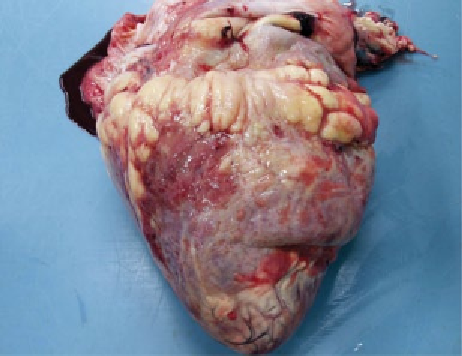Agriculture Reference
In-Depth Information
Pericarditis
Pericarditis
(inflammation of the pericardium) may be
serous (early stages), fibrinous or septic. Early stages
show hyperaemia with a thin, clear exudate.
Fibrinous pericarditis:
In later stages, greyish-white
fibrin strands are formed, sometimes flecked with blood,
and the exudate is reduced in amount. In chronic fibrin-
ous pericarditis, the fibrinous exudate appears as villous
strands when the epicardium and pericardium are sepa-
rated - 'bread-and-butter' pericarditis.
Septic or purulent pericarditis:
The presence of
pyogenic bacteria is indicated by the appearance of pus
which varies in consistency and colour according to
the types of organisms involved - thin, whitish pus or
thick creamy, yellowish, yellowish-green or greenish
pus. Putrefactive bacteria produce a foul smelling pus
(Fig. 9.18).
Septic pericarditis
is the form occurring in
traumatic
reticulopericarditis
in cattle. (Traumatic pericarditis can
also occur in the horse and sheep.) Early forms show the
aforementioned septic changes, but more chronic cases
reveal varying deposits of fibrin which fuse the epicar-
dium and pericardium together. The pericardial sac itself
is thickened, and there is usually a fistulous cord-like
fibrous tract (which may contain some pus) connecting
the reticulum and pericardium.
A.
(
formally C
.)
pyogenes
is the most common organism in a mixed flora which
may contain anaerobic gas-forming bacteria. A local
chronic peritonitis is frequently associated with the
fistulous tract and may give rise to adhesions between
the diaphragm, pericardial sac and anterior aspect of the
reticulum. Pleural and pneumonic changes are frequent
associates. Bacteria may pass from the infected pericar-
dial sac into the bloodstream, producing septicaemia,
but more commonly the infective material remains
encapsulated with toxins being released to cause
cachexia.
Traumatic reticulopericarditis
occurs most often in
cows over 4 years of age, often shortly after parturition.
Its frequency is related to the bovine habit of licking and
swallowing various foreign bodies and the close relation-
ship of the reticulum and the heart. These organs are
about 5 cm apart during expiration and 2.5 cm during
inspiration. The regular movement of the diaphragm
during respiration facilitates the forward movement of
sharp objects through the anteroventral border of the
reticulum and the diaphragm to penetrate the pericar-
dial sac at the apex of the heart. Occasionally, sharp
objects may penetrate the myocardium, lung, pleura,
liver or spleen.
(a)
Pyelonephritis
Pyelonephritis
is a fairly common disease in cows, gener-
ally occurring as a sequel to parturition, but it also affects
sows (mainly the acute form). It is rare in calves, horses,
sheep and goats. It attacks the kidney pelvis and paren-
chyma and results from ascending infection. As with
other kidney infections, it may be acute, chronic, septic
or non-septic.
The condition is probably a mixed bacterial one, but a
prominent organism appears to be
Actinobaculum suis
.
Pyelonephritis may be unilateral or bilateral and is
manifested by catarrh and dilatation of the renal pel-
vis which is filled with a slimy detritus which may
contain fibrinous clot or pus and possesses a strong
ammoniacal odour. The acute form begins with
inflammation and necrosis of the renal crest (projec-
tion of the renal medulla into the pelvis containing
the openings of the tubules). At this stage, the paren-
chyma is swollen, dark red and firm. Haemorrhages
(b)
Figure 9.18
Pericarditis. (a) Simple fibrinous pericarditis.
(b) Suppurative pericarditis with fibrino-purulent exudate
(Courtesy of Hal Thompson).


